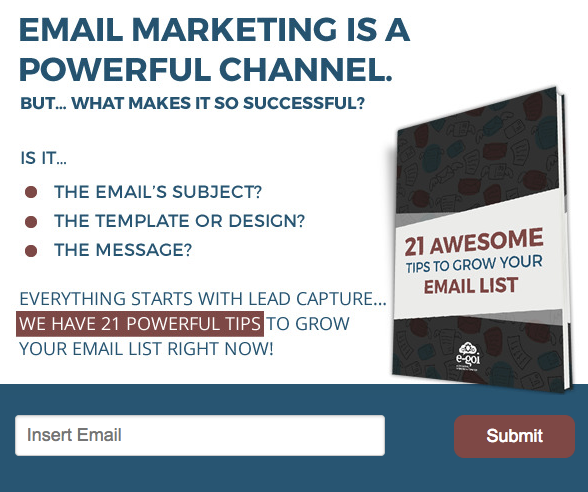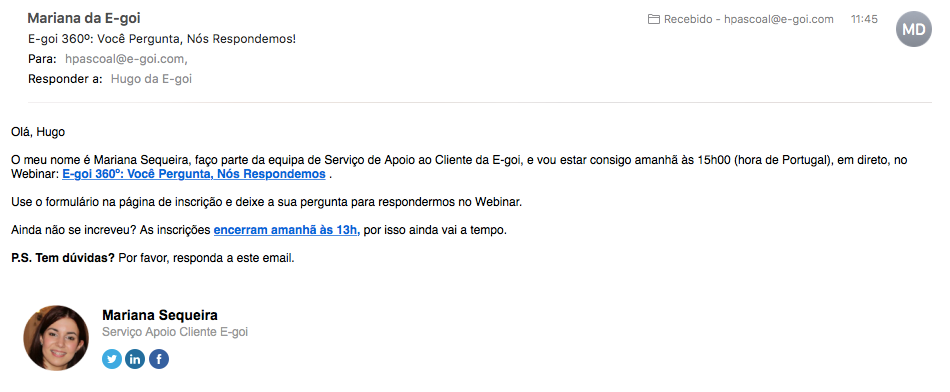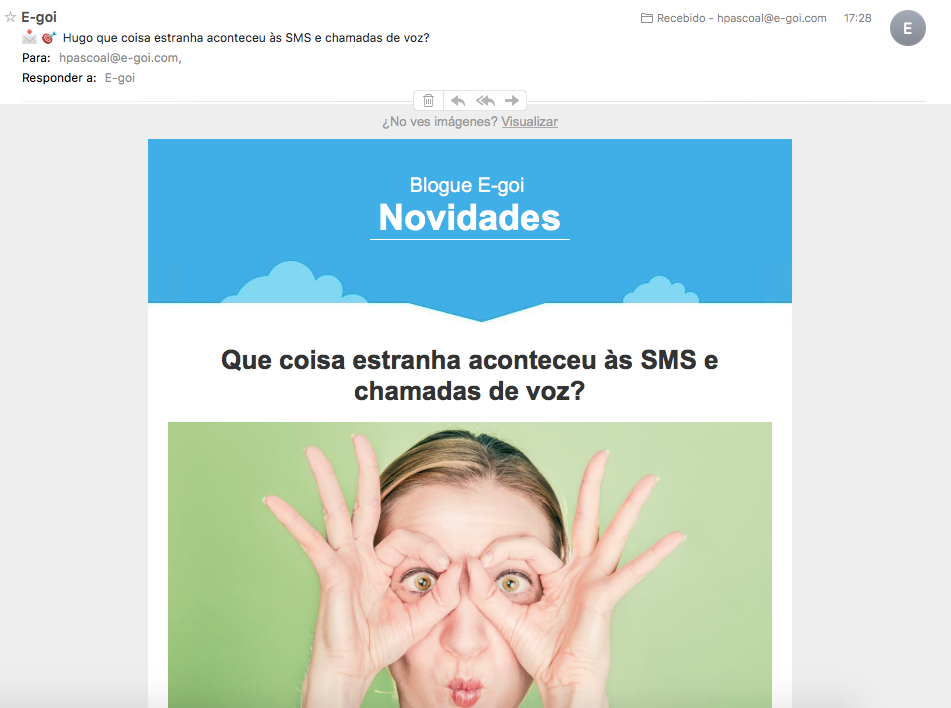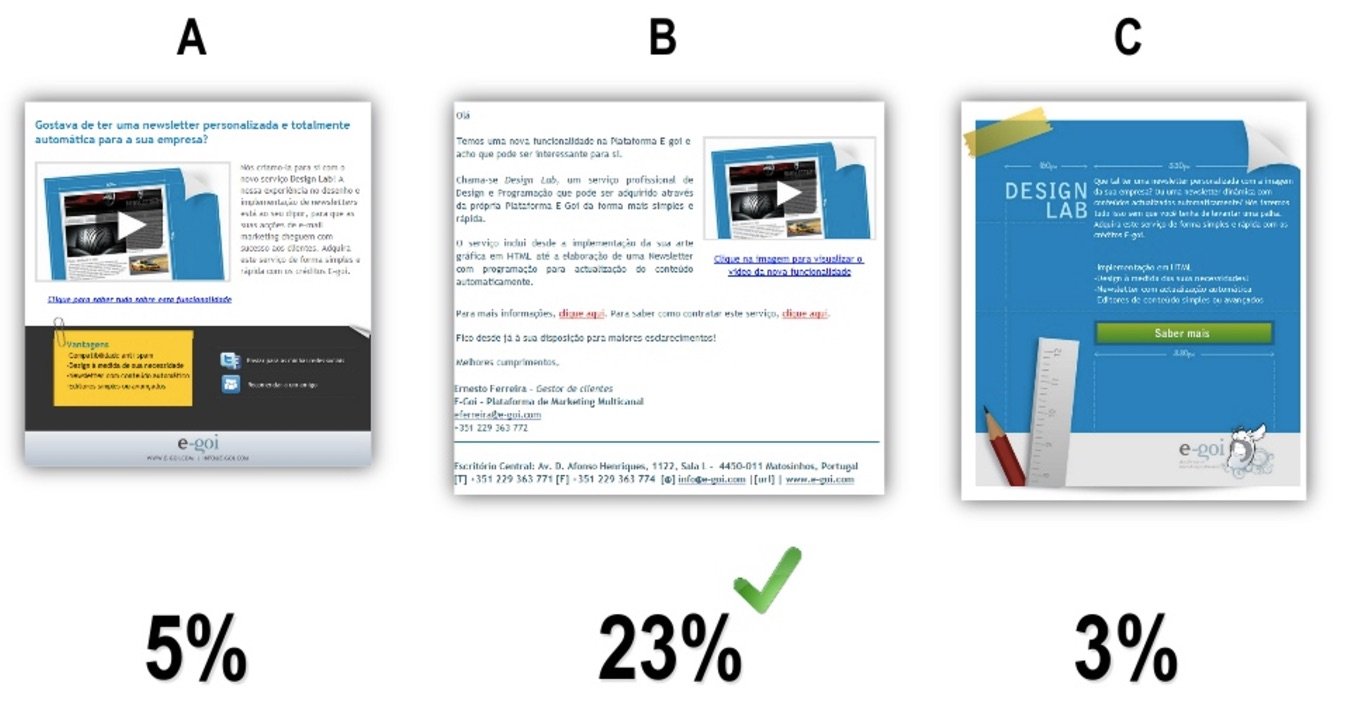Everyone says that email marketing is dead, but the truth is that email marketing is still an essential element of digital marketing. Every dollar invested will generate an average return of 38 dollars. If you have an online shop, you undoubtedly know how much this can impact your sales and your client relationships. So is […]
Everyone says that email marketing is dead, but the truth is that email marketing is still an essential element of digital marketing. Every dollar invested will generate an average return of 38 dollars.
If you have an online shop, you undoubtedly know how much this can impact your sales and your client relationships.
So is it worth investing in email marketing? Absolutely!
Is email marketing easy? Not exactly.
In reality there are many businesses that already realise that email marketing works, but they don’t know where to start and are therefore missing out on opportunities.
E-goi has case studies which show that clients such as Caio, 3-D architecture specialists, reached an incredible unique opening rate 65%! Anyone who works with email marketing knows how difficult it is to achieve this. But we’re going to help you and our advice will help you get on the right track.
Contents
1. Define your objectives
Already thought about sending your newsletter? There is a very important element in every strategy which is very often neglected: which problem are you trying to solve? Is there a particular business opportunity that you want to explore? What is your objective?
Some of your email marketing campaign objectives could be: increase the number of visitors to your blog or website, increase sales, obtain feedback via a questionnaire, grow your mailing list or simply interact with your audience. There are dozens of types of email marketing.
Be clear on this before starting your email marketing campaign. And more importantly, establish targets and have your numbers in mind. For example: I want to close 50 sales or obtain 200 new leads for my email list.
2. Define your strategy
Now that you have defined your objectives, let’s align a strategy for your campaign. Imagine that you want to recover inactive clients.
What will be the best strategy? Offer a discount? Tell them about that new feature, the one the client complained that your service didn’t offer, and which was the reason they opted out? Offer free delivery?
But what if you want to sell more to your existing clients? Are you going to send a selection of products that complement those they’ve already bought?
And what if you’re looking for new clients? We offer a free webinar about the benefits of that product? Hold a prize draw?
I think you already get the picture. Clearly define what exactly will influence your results according to your objectives.
3. Choose an email marketing service
Carefully select the email marketing service you’re going to use. Here are some warning signs when making your choice.
Beware of self hosted services which offer a mailing service, but for which you have to set up the outgoing mail services and optimise them for email marketing, which will involve more costs and use up extra resources.
At E-goi, we use our own email marketing software, which is a SaaS (Software as a Service), and is exactly the opposite of self hosted software. In other words, E-goi offers the service and all of the technical infrastructure for outgoing mail servers, leaving you to focus on your strategy, your objectives and implementing your campaign.
4. Already have a mailing list?
Already chosen an email marketing service? Great! But before you start, you need a mailing list. You can start with buying one, right? Wrong! Don’t bother. It will just give you hassle. It’s like letting yourself into somebody’s house, and then once you’re in there ask if it’s okay to come in.
Aren’t you fed up of receiving emails in your inbox from people you’ve never heard of? So don’t do the same! Check these 21 tips to grow your email lists.
5. The ultimate guide to email marketing: Good practices
5.1. Start with the sender
What’s the first thing you notice when you receive an email? The sender, right?
The bigger the prestige of your brand or the audience engagement, the higher the opening rate tends to be. But if you have a start-up or a small business, it’s natural that your communication and branding budget will be tight or non-existent, and the priority will be placed on advertising or on the salesforce alone. But do not despair. It is not impossible to get excellent results.
One thing we’ve learned with the many tests we have done is that personalised communication tends to generate better results. If you use myname@mycompany.com you will normally get better results than using general@mycompany.com.
5.2. Create attractive subject lines
It’s important to have a good idea of how to attract the reader’s attention. Which of these subject line options do you think is more attractive?
– New E-goi blog post
– 8 Incredible Ways to Start Your Email Marketing Journey
The second one is obviously more attractive. I’ve been experimenting in recent months and I’ve noticed that one of the techniques that will guarantee a higher opening rate, is using emojis. Personalising emails with people’s names is another strategy that attracts the reader’s attention, therefore increasing the chances of them opening it.
Remember that we receive hundreds of emails every day and for this reason, they should always include something that differentiates them from the rest.
Don’t forget that we have less and less time available, so the shorter the subject line, the more likely it is that the reader will absorb the information.
5.3. Images
When you leave email campaign creation in the hands of a web designer, it’s highly likely that you will have an attractive newsletter with several well-presented images, from a graphics point of view, but this doesn’t mean you’ll get good results.
Images that are too big will be blocked by ISPs. Apart from that, a balance between text and images is important, otherwise ISPs will interpret this as an attempt to conceal the message and will send your emails straight to SPAM.
5.4. Call to action
A call to action is the component that will encourage, or not, the reader to follow the path you have traced towards your objective.
From my experience, click rate is always higher when the button is placed within the first 300px of the email body. In lower resolutions, there is a possibility that when an email is viewed via desktop, the button does not appear. This detail can make a difference to the impact your campaign has. Always test your campaign in a range of resolutions, especially on mobile, so that the reader will have the best possible reading experience.
Remember that you should ideally concentrate on one single objective, whether it’s a capture page, a sales page or simply an article like the one you are reading.
5.5. Removal
Take removal requests very seriously. If you receive a lot of requests, you need to immediately rethink your strategy. Your mailing list is reacting negatively to your content and you will probably start to receive complaints about spam.
My advice to you may seem strange, but believe me, it’s highly effective. Place the unsubscribe button right at the start of your newsletter, leaving it very clear that you only wish to send emails to those who are really interested. I hear you ask: but that surely only increase removals?
Yes it will, but there will be no more SPAM complaints, your opening rate will increase and ISPs will start trusting you and deliver your emails right into the inbox.
6. Planning
Knowing how to email in the right dosage is just as important as understanding good practices in email marketing. How many times has a particular company left you with a negative feeling, causing you to curse: ‘This company sends me so many emails!’ They’re such a pain!’
6.1. Sending times
However interesting your messages are, you quickly need to determine the frequency and ideal time for sending them. My experience with B2B is that the best sending days are from Tuesday to Friday, between 08:00–09:00. This is because on Mondays, inboxes are full of accumulated emails from the weekend and the first thing you do when you get to the office is read your emails, isn’t it?
With B2C, however, lunchtimes, after dinner on Fridays or the weekends tend to be more favourable for opening emails, as people have more free time. Remember this is not an exact science and every case is different.
6.2. Frequency
With regards to frequency, I recommend that you start with one message per week and slowly increase the number of emails, sending at a variety of days and times. Make comparisons to establish patterns of the best days and times to send. Again, every case is different.
6.3. Organisation
Use a tool that helps you organise your mailings and create your own editorial calendar. This could be your CRM or even a cooperative working tool like Trello or Slack.
If you’re lacking creativity you can always use E-goi’s marketing and social media calendar for 2017, which has dozens of holidays and special occasions to inspire you.
7. Segmentation
Less is more! When it comes to sending your campaign, most people would be tempted to think: the more people I send to, the better my results will be, right? False!
I understand that it’s very tempting (partly because I also thought the same a few years ago), but always try to segment your database and send to less people. Believe me, it’s worth it! What’s more, you will be avoiding unnecessary removal requests or SPAM complaints that jeopardise your deliverability.
This may seem obvious, but we’ve performed several tests here at E-goi that have proven this.
8. Analysis and Testing
Having completed the steps, it’s time to analyse the results. There are several criteria to analyse: opening rate and click numbers, bounce rate, SPAM complaints and conversions.
After analysing this data, you should ask some questions, such as:
– Was there a deliverability problem with a specific ISP?
– Was the offer appropriate?
– How do the email perform on mobile?
– Did I segment my list correctly?
Basically, you need to understand whether your campaign was correctly set up from a technical point of view (most email marketing software usually tell you everything you need to know) and if your campaign was correctly segmented. If all of this was in order, then you really need to examine your strategy and quickly change it, so as not to repeat the same mistakes.
For example, A/B testing is a easily accessible and powerful tool and which allows you to create several versions of the same newsletter, testing them with a sample of your mailing list in order to determine which version will bring you the best results. Everything can be tested: from the subject line, position of the call to action, the copy or even the sending time.
For this test we randomly sent 3 different newsletters to a sample representing 15% of our mailing list. The winning newsletter will be the one with the highest opening rate and will be sent to the remaining 85% of the segment we established. There was a clear winner, which even led us to change the way we were communicating, and that this reason is a highly recommended technique.
Conclusion
If you are in doubt about the effectiveness of the email marketing channel, I think I may have changed your opinion and that you now have a much clearer idea about all the things you can do to improve your results. Apply all of the strategies shown in this article and you will undoubtedly see short-term results.
Email marketing can have far-reaching effects and could even influence your SEO results (we use SEMrush as a SEO tool here at E-goi and one which we highly recommend).
What about you? Do you have a successful email marketing case study? Share it with us in the comments below!





